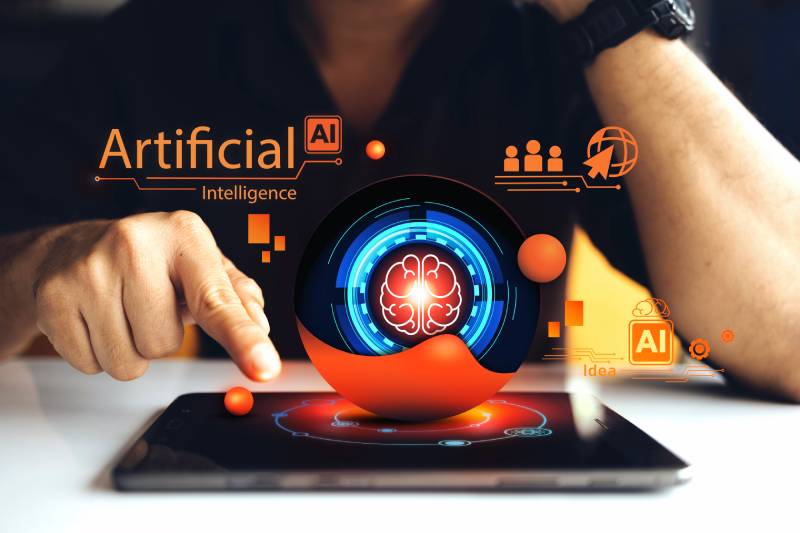In just a few years, artificial intelligence (AI) has evolved from a novel curiosity into a dominant global trend, revolutionizing digital marketing landscapes. Unlike passing technological fads, AI content creation is establishing itself as a cornerstone of digital marketing and content marketing trends because it solves the real problem of scalable, high-quality content production. This leads directly to the content bottleneck—where content creation becomes a tedious, time-intensive process that’s difficult to scale, draining your resources and slowing progress.
Generative AI offers a powerful solution by enabling efficient content generation based on data patterns, helping you overcome these hurdles. However, it’s not a magic wand; generative AI requires your creative input and strategic oversight to yield the best outcomes.
This guide will explore how to leverage this tool effectively, starting with the key benefits it brings to your marketing efforts.
Generative AI as a Solution for Modern Content Demands
Marketers are constantly being tasked to do more with fewer resources and in less time, and generative AI directly addresses this challenge by offering efficient solutions.
The primary advantage of generative AI is faster content production, as AI tools can churn out content at an astonishing pace, saving valuable time.
This approach isn’t about replacing human creativity; it’s about compressing the time spent on mechanical aspects like research, outlining, and drafting so you can focus on the strategic and creative layers that only you can provide.
What used to take an entire afternoon—staring at a blank screen, researching, outlining, drafting—can now be compressed into a focused hour of strategic input and editing, making your workflow much more efficient. Therefore, this enhanced speed allows your marketing team to react quickly to news and market trends, incorporating new information effectively to maintain a positive customer experience.
Beyond time savings, AI is also incredibly cost-effective, providing a budget-friendly alternative for content creation.
- For small business owners, the traditional solution—hiring a marketing agency or bringing on a full-time marketing coordinator—often comes with costs that feel prohibitive, making AI an attractive option.
- Generative AI offers a cost-effective path to consistent content creation, allowing smaller teams to scale their marketing efforts without breaking the bank.
This leads directly to scalability, where using natural language processing (NLP), generative AI can create large amounts of content quickly and accurately, enabling businesses to expand their content output rapidly.
- For example, if you need to create hundreds of product descriptions or meta titles for a new site or a new batch of products at your store, AI can accomplish that in a single day.
- Similarly, AI is a great tool for repurposing content, such as breaking down long blog posts into shorter social media posts, enhancing your content strategy.
Another standout feature is personalization at scale, where generative AI has the ability to create personalized content for different audiences, tailoring messages to specific needs.
- For instance, AI can tailor marketing campaigns to your Ideal Customer Profile (ICP), creating highly targeted content that speaks directly to each person, which would normally take much longer manually.
These powerful benefits make a compelling case for adopting AI, but harnessing its full potential requires a structured and strategic approach to implementation.

A Practical Workflow for Integrating AI Into Content Creation
This is exactly the reason why, to effectively integrate AI into one of the most significant digital marketing trends, it’s essential to follow a structured workflow that blends automation with human oversight.
- Define Your Content Strategy: Start by establishing a clear content strategy before you even open an AI tool; this involves defining your vision, goals, and ideal reader.
Remember, the more detailed information and guidance you provide in your prompts, the more effective the generative AI will be in creating high-quality content that resonates. Investing time in crafting precise prompts ensures that the AI understands your needs and delivers better results.
- Use AI for Ideation and Outlining: Use AI as a brainstorming partner to overcome the challenge of finding a great topic. Ask it to generate multiple angles, outline potential sections, or suggest different perspectives based on your content strategy.
- Generate the First Draft: Once you have a solid outline, you can use the generative AI tool for creating first drafts. In many cases, this initial output can get you about 80% of the way to a finished piece in just a few seconds, significantly speeding up the drafting process.
- Strategic Editing and Human Input: The most critical step is the strategic editing and human input that follows. This is your moment to inject the authentic insight, hard-won perspective, and distinct brand voice that only human expertise can provide to ensure authenticity.
This editing process is also how you determine if the AI needs more training on your specific tone, helping to refine future outputs and improve overall content quality. Through this, you provide training data that refines the AI on your brand voice, creating a feedback loop for continuous improvement.
Ultimately, the difference between businesses that succeed with AI and those that do not often comes down to successful workflow integration. This final stage of human-led editing is non-negotiable, not just for enhancing quality, but for mitigating the inherent limitations and risks of the technology, which we will explore next.
Also Read : Making Sense of User Data With Effective Analytics Tools
Balancing AI Efficiency With Human Expertise and Oversight
While the benefits of AI are clear, you must understand that one of the biggest limits of current generative AI models is the risk of providing wrong data. On top of that, AI can sometimes hallucinate and make up information, and its limited access to current events means it can’t use reasoning or verify new data.
Furthermore, because generative AI is still in its early stages, models are often trained on limited data sets, which can result in AI-generated responses that contain bias. By definition, this makes the output derivative and means AI-generated content can lack the authenticity and expert opinions needed to meet high-quality standards.
This is where the indispensable role of human oversight becomes the key to balancing AI’s speed with quality.
- The first non-negotiable step is rigorous fact-checking, where every statement or data point provided by the AI is verified for accuracy. This isn’t just a best practice; it’s a critical process to avoid publishing factual inaccuracies that could erode brand trust.
- Next is strategic editing, where you improve the AI-generated text by adding more context, unique insights, and a distinct brand voice. This layer of human expertise is what ensures authenticity, transforming a competent piece of AI-generated content into genuine thought leadership.
- Finally, you must take accountability for mistakes, review and edit AI-generated responses to avoid bias, and be transparent about using AI.
To get the most from these powerful digital marketing trends, you must balance AI with the irreplaceable value of human judgment and expertise. This essential partnership between AI’s efficiency and human expertise is the core principle for successfully integrating this technology into a long-term strategy.
Making AI a Sustainable Part of Your Content Strategy
The key to success in today’s digital landscape is viewing generative AI as a strategic tool that partners with human expertise within your overarching content strategy, not as a standalone solution.
As these digital marketing trends advance, generative AI technology is constantly evolving, meaning the tools and capabilities you use today could be significantly enhanced or replaced in the near future.
Therefore:
- Focus on leveraging generative AI to boost your creativity and productivity.
- Always apply human expertise for critical tasks like fact-checking and strategic editing.
To get started, begin small by selecting one content format—perhaps a monthly blog post or quarterly whitepaper—and integrate it into an AI-assisted workflow integration for a three-month trial.
Ultimately, this approach enables you to scale your content production effectively, competing with larger firms while highlighting the unique value of your human expertise and robust content strategy.






